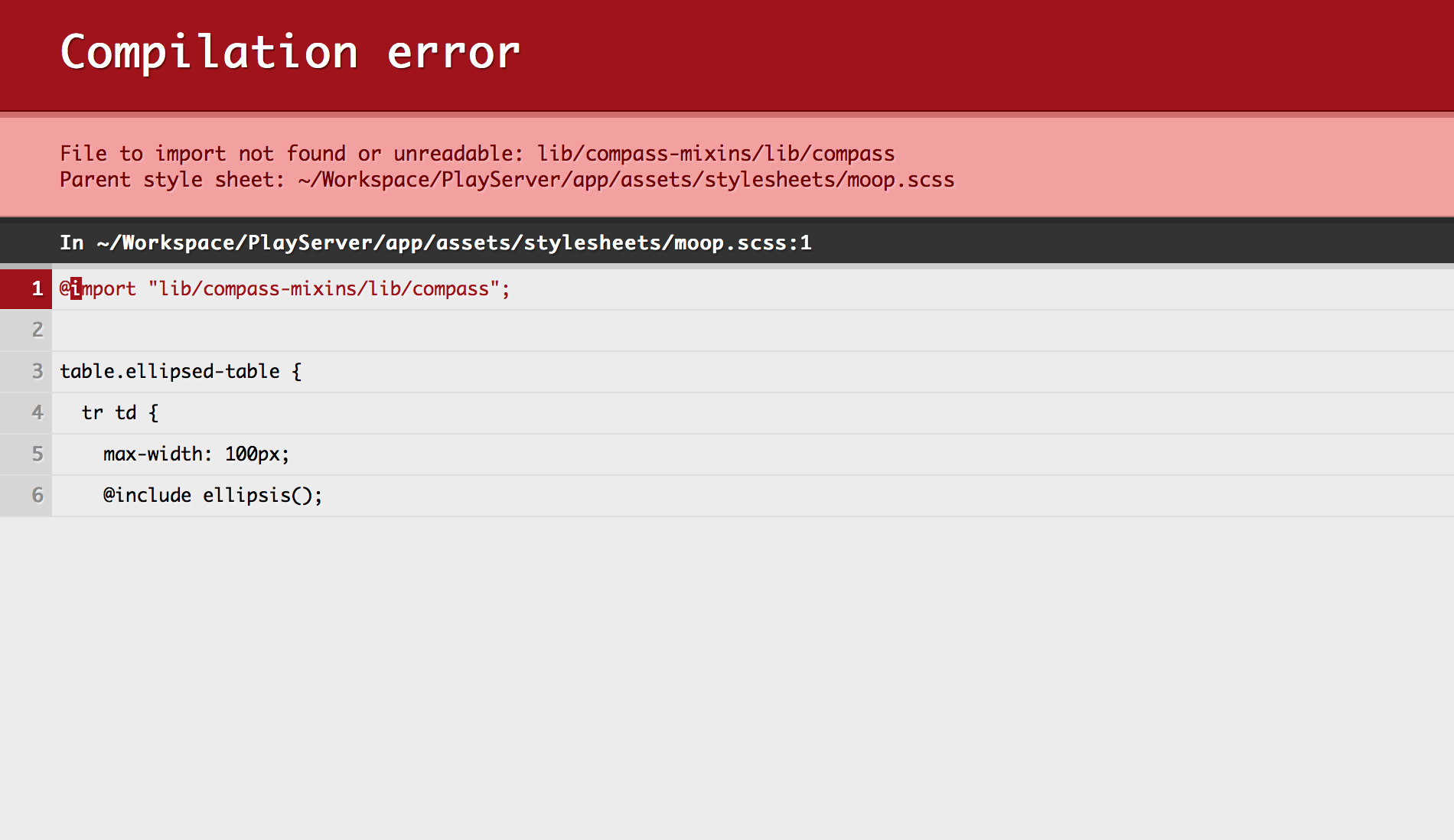§Using Sass
Sass is a dynamic stylesheet language. It allows considerable flexibility in the way you write CSS files including support for variables, mixins and more.
Compilable assets in Play are typically defined in the app/assets directory. They are handled by the build process, and Sass sources are compiled into standard CSS files. The generated CSS files are distributed as standard resources into the same public/ folder as the unmanaged assets, meaning that there is no difference in the way you use them once compiled.
For example, Sass source file app/assets/stylesheets/main.scss will be available as standard CSS resource, at public/stylesheets/main.css.
Sass sources are compiled automatically during an assets command, or when you refresh any page in your browser while you are running in development mode. Any compilation errors will be displayed in your browser:
§Working with partial Sass source files
Any Sass file (*.scss/*.sass) will automatically be compiled. The Sass plugin will automatically determine which Sass syntax is being used (indented or not) based on the filename. A file who’s name starts with an _ will not be compiled separately. However, such files can be included in other Sass files by using the standard Sass import feature.
§Layout
Below an example layout for using Sass in your project is given:
app
└ assets
└ stylesheets
└ main.scss
└ utils
└ _reset.scss
└ _layout.scss
Given the following main.scss source:
@import "utils/reset";
@import "utils/layout";
h1 {
color: red;
}
The Sass file outlined above, will be compiled into public/stylesheets/main.css. Hence, this file can be used in your template as any regular public asset:
<link rel="stylesheet" href="@routes.Assets.at("stylesheets/main.css")">
§Mixing Sass and web-jars
WebJars enable us to depend on client libraries without pulling all dependencies into our own code base manually.
Compass is a library containing all sorts of reusable functions and mixins for Sass. Unfortunately, this library is targeted towards the Ruby implementation of Sass. There is a number of useful mixins that can be extracted from it. Fortunately, these mixins are wrapped in a web-jar.
To include these compass mixins in your project is as easy as including the web-jar dependency in your library dependencies. For example, within a build.sbt file:
libraryDependencies += "org.webjars.bower" % "compass-mixins" % "0.12.7"
sbt-web will automatically extract WebJars into a lib directory relative to your asset’s target directory. Therefore to use the Compass mixins you can import the mixins by:
@import "lib/compass-mixins/lib/compass";
table.ellipsed-table {
tr td {
max-width: 100px;
@include ellipsis();
}
}
The same idea can be used to include other Sass libraries, for instance the official Sass port of bootstrap. To include the WebJar use:
libraryDependencies += "org.webjars.bower" % "bootstrap-sass" % "3.3.6"
Then to use it in your project, you can use:
@import "lib/bootstrap-sass/assets/stylesheets/bootstrap";
§Enablement and Configuration
Sass compilation is enabled by simply adding the sbt-sassify plugin to your plugins.sbt file when using the PlayJava or PlayScala plugins:
addSbtPlugin("org.irundaia.sbt" % "sbt-sassify" % "1.4.2")
The plugin’s default configuration should normally be sufficient. However please refer to the plugin’s documentation for information on how it may be configured as well as its latest version.
Next: Using JSHint
Found an error in this documentation? The source code for this page can be found here. After reading the documentation guidelines, please feel free to contribute a pull request. Have questions or advice to share? Go to our community forums to start a conversation with the community.




